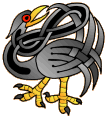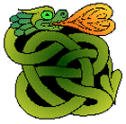|
Symbolism
The Awen: /|\ Three upright bars, with the tops of the outer
two bars leaning toward the top of the center bar. Sometimes the Awen is draw with three stars within a circle, or just circles
above it. The word "Awen" is Welsh for "inspiration". The symbol stands for truth, knowledge, and justice. The Circle: The circle represents a continuous cycle. from birth
to life to death to rebirth. It is added on the cross to make a celtic cross, a tribute to druids of days gone by. The Celtic Cross: A Christian Cross with a circle surrounding
the middle point where the vertical and horizontal lines of the Cross intersect. The Druid Sigil: A circle intersected by two vertical lines.
In Stuart Piggot's book "The Druids", there is a photo of a Romano-British building, possibly a temple, located at Black Holmes,
Thistleton, Leicestershire (England) in which this symbol forms the foundation. The Henge of Keltria, a large Druid organization
in the United States, uses this symbol.
The Horned God An image of a male God with horns on his head,
usually stag antlers but sometimes small bull horns. This god is usually referred to as Cernunnos. A male god of earth and
the hunt. He is depicted as various animals rolled into one surrounded usually by trees. The 6th Moon: The time between the cresent moon and new moon
were said to be the times when the veil to the otherworld were thin and magic would be stronger. The Tree: A primary symbol of Druidism, however, each species
of tree known to the Druids had a meaning of its own. The tree is the connection between all elements. It reaches from the
earth to meet the sky bringing forth water, yet providing fire and warmth. Half of the tree extends above earth and half below,
representing balance.
The Head: The Head represents the connection of mind, body, and
spirit. To behead would ensure a continued death. Long White Beards: The Druids and all the Druid nation was known
for having "wild" hair which flew about them in battle. This included beards and even eyebrows on some. Mistletoe: Mistletoe was considered
to be the heal all herb. Particularly potent when collected from the oak at a certain time of the year. Scientists are now
finding that "myth" to be very much true.
Curved blade, Sickle or Scyth: Pliny, a Roman historian, recorded a Druid ritual in which mistletoe was cut from an oak tree by a Druid in white robes,
using a gold sickle. The mistletoe was to be caught in wicker baskets and not allowed to touch the ground. We all have seen
the classic picture of a druid in a tree cutting the mistletoe with a sickle while other druids wait below to catch the mistletoe
in their white robes. It has been discovered that the mistletoe ritual was indeed based on fact and reasoning. Gold is a metal
that seems to be the least offensive in contamination, however it is to soft to cut with, therefore the knife was probably
a mix of gold and another metal. Perhaps pyrite (fools gold) or entirely made of brass. It would have been caught prior to
touching the ground to prevent contamination. The cresent shaped knife is well known to cut easily and effectively. Druid Rod or Staff: Druids used a staff as a type of conductor for majick. It had to be made of wood, and the type of wood used depended
on the type of majick that it would partake in. A metal rod could result in a surge and harm the holder. Gems can be added
to the staff to increase its power and reflect it onto the desired course. Similar to a lazer. Bell Branch: This
was traditionally a silver tree branch with gold bells attached to it. The sound of the bells is pleasing to the Gods and
attracts their attention, while at the same time it is offensive to the ears of malevolent spirits who are driven away. Some
stories include a goddess who invites a human into her home by presenting him with a brach with bells, fruit, or blossoms
on it. This tool is used by some groups to help draw spirits from the other realm. the bell branch would be known to others
as "the golden bough." The golden bough is a branch from the oak tree that has mistletoa attached to it. In the Britain area
the mistletoe berries are white, however in other parts of the world, they are yellow. Crane Bag: The
Crane bag belonged to Cumhall, father of Fionn Mac Cumhall, which Fionn had to recover when it was stolen. It contained many
treasures from such deities as Manannan and Giobhniu, and would be full at high tide and empty at low tide. One of these treasures
apparently was additional letters for the Ogham. Modern druids use leather or cloth pouches to hold their most precious
tools. Cauldron: The
cauldron is a prominent tool used for everything from basic cooking, to making herbal concoctions, to making candles. Dagda
and Cerridwen both had majickal cauldrons, and cauldrons are often mentioned in celtic tales. Some were said to bring wisdom
to those who drank from it, and another was said to bring the dead back to life. Archaeologists have uncovered several cauldrons
and buckets that were ornamented for ritual uses. Animal and plants: The druids believed everything had a purpose and reason, and nothing went to waste, not even the remains of an animal.
The uses could be anything from cloths to medicinal or as talisman. Cloths could be made from the skins of animals as well
as from feathers. Plants and trees all had a purpose as well, for majick, construction, and healing. The use of sacred plants
in paganism was so strong that the Catholic Church forbade the presence of mistletoe and holly in its churches. Musical instruments: Harps, drums and woodwind instruments such as whistle, flutes and pipes are all a part of druid structure. Drums and
woodwinds (horns) could be made from animals, and woodwinds from various woods and reeds. Musical instruments are used not
only for connections with the spirits but can enchant animals. Stones and
gems: Druids primarily gathered in tree groves as the provide protection from the elements while still remaining withing
the elements. However stone circles were often used as well. The stone circle is often where mass gatherings occured and ceromonies
were performed. The stones acted as a grounding force. With the occurance of majick, a grounding element must always be applied.
Gems, metals in the form of stones, and other stonelike objects were often used for their healing and grounding properties.
Druid Egg: All animals were believed
to have meaning and special attributes. However, certain animals are mentioned more than others and hold special symbolism
to the Druids. More information on these animals is provided in the animal section.
Deer:
The deer sometimes indicates the presence of an enterance into the Otherworld. She represents the unconditional
faith and trust necessary to enter.
Serpents and Dragons:
The dragon and serpent represent the deepest inner abilities that we hold within ourselves. When Saint Padraig (Patrick) banished
the serpents from Ireland, perhaps this is a metaphor for the banishing of the Druids.
Cow:
Cattle had various meanings from economic stature to fertility.
|
|
|












